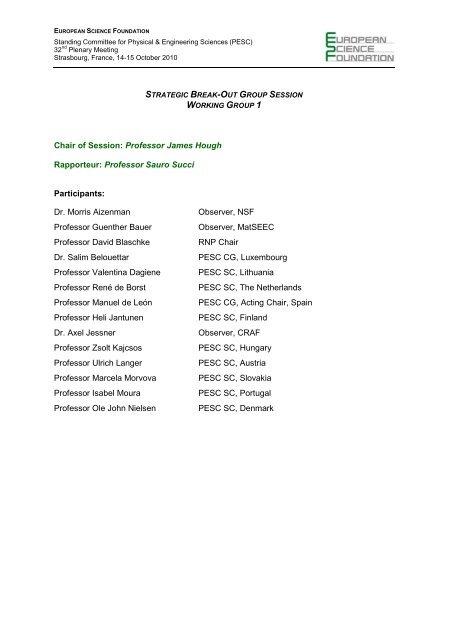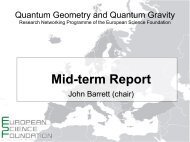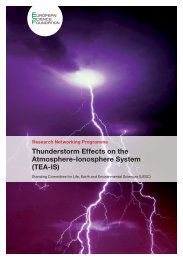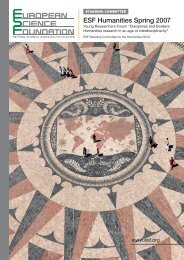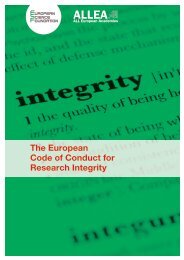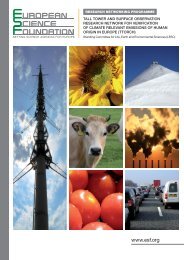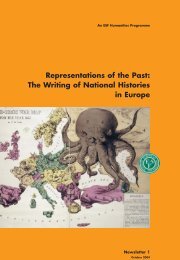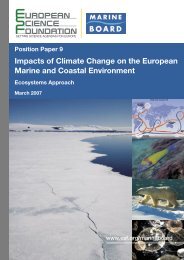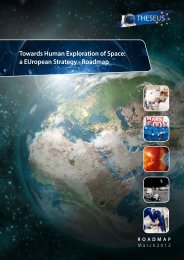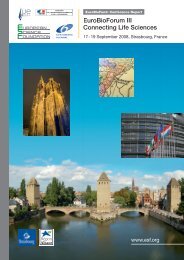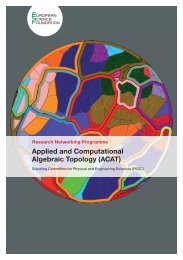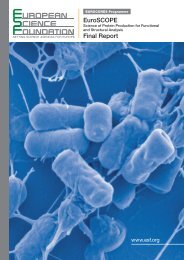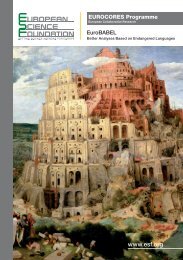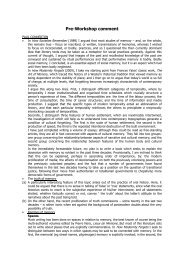LIST OF PARTICIPANTS AS OF - European Science Foundation
LIST OF PARTICIPANTS AS OF - European Science Foundation
LIST OF PARTICIPANTS AS OF - European Science Foundation
You also want an ePaper? Increase the reach of your titles
YUMPU automatically turns print PDFs into web optimized ePapers that Google loves.
EUROPEAN SCIENCE FOUNDATIONStanding Committee for Physical & Engineering <strong>Science</strong>s (PESC)32 nd Plenary MeetingStrasbourg, France, 14-15 October 2010STRATEGIC BREAK-OUT GROUP SESSIONWORKING GROUP 1Chair of Session: Professor James HoughRapporteur: Professor Sauro SucciParticipants:Dr. Morris AizenmanProfessor Guenther BauerProfessor David BlaschkeDr. Salim BelouettarProfessor Valentina DagieneProfessor René de BorstProfessor Manuel de LeónProfessor Heli JantunenDr. Axel JessnerProfessor Zsolt KajcsosProfessor Ulrich LangerProfessor Marcela MorvovaProfessor Isabel MouraProfessor Ole John NielsenObserver, NSFObserver, MatSEECRNP ChairPESC CG, LuxembourgPESC SC, LithuaniaPESC SC, The NetherlandsPESC CG, Acting Chair, SpainPESC SC, FinlandObserver, CRAFPESC SC, HungaryPESC SC, AustriaPESC SC, SlovakiaPESC SC, PortugalPESC SC, Denmark
The following DRAFT provisional mission statement has been prepared following thediscussions at the recent ESF Governing Council:Mission StatementThe <strong>European</strong> Research Organisation (ERO) promotes the collective interests ofthe Research Funding and Research Performing Organisations of Europe. Itsupports its member organisations in their efforts to foster <strong>European</strong> research. Itwill strengthen the <strong>European</strong> Research Area through its direct engagement withkey partners. In doing so it will be informed by direct representation of allscientific communities in its reflections on policies, priorities and strategiesTaking this as a context, each Working Group discussed both particular issues:(A) It is possible that any future organisation will have a scientific committee structure toprovide advice and connection with the research community.Starting with “a blank sheet of paper”, what might be a model for such a newcommittee structure, in terms of size, structure and scientific domains. Interms of domains, particular attention should be paid to the physical andengineering sciences and also their interfacing domains.(B) It is possible that any future organisation may wish to have “in house” the means todeliver its strategies (eg schemes and instruments).Starting with “a blank sheet of paper”, what types of instruments andschemes might be required to deliver such a mission as outlined above.
Summary breakout session, Working Group 1A. Possible structure of any future organisationNeed for an organisation with a flat hierarchy with appropriate representation of allsections and faculties in <strong>European</strong> <strong>Science</strong>o taking into account their complexity (eg enormous varieties, constraintsaccording to the areas of science)o having a direct relation to inside but also outside the academic world in orderto advise on strategic decisions.o with non-bureaucratic support for basic scienceo with a bottom-up approacho Strategy and funding should be in the same organisation.Two possible structures proposed which would give Horcs the possibility to exertinfluence within EU:A) Very basic two layer structureB) Organisation with <strong>Science</strong> and Expert Boards enabling the flow of information:o Top Level: Heads of Organisationso 1 st Level: Scientific Advisory Board with a Chair reporting to the Heads ofOrganisationso 2 nd Level:4 separate faculties with representatives to the Scientific Board• Physical and Engineering <strong>Science</strong>s• Life <strong>Science</strong>s (Biology – Medical)• Social sciences• Humanities+ Potential other Expert BoardsESF Expert Committees’ point of view is that they would need to influence at ahigher political level and would wish to be embedded in a more strategicorganisation.Views from the US National <strong>Science</strong> <strong>Foundation</strong>:o The ESF’s role is to encourage communication among the different scienceswhereas ERC provides funding onlyo The US NSF combines both the funding and the networking functions byfunding conferences and basic research. NSF does not functionindependently from the scientific community in terms of advice.o All funding decisions must be approved by the National <strong>Science</strong> Board whichtechnically runs the NSF.o A Roadmap for science is produced every 10 years by the US NationalAcademy of <strong>Science</strong>s, an honorific society, and provides recommendationson future perspectives and priorities.
Long-term view for <strong>European</strong> <strong>Science</strong>o The missing link is lack of synergy between all <strong>European</strong> Organisations(ESF, ERC, COST etc…)o There is a need to avoid duplication of effortso The new structure should aim at a higher visibilityo In order to have a single voice for research in Europe, the new organisationshould bring strategy/policy and funding together in order to be morepowerful.o It should be taken into consideration that 90% of the <strong>European</strong> ResearchOrganisations’ budget is to be spent at national level whereas only 10% isspent at <strong>European</strong> level.In the process of consolidation, the longer term aim would therefore be tomerge ESF/EUROHORCs with ERC, so as to produce a “tiger with teeth”,still preserving the good aspects of ESF. The <strong>European</strong> Academies(ALLEA) could provide advice to the organisation on strategic issues.B. Possible Instruments and schemes for the new organisationWhile there is a need for future cooperation at the <strong>European</strong> level, bilateral or threelateral connections should also be developed.The best tools from each organisation (ESF, ERC, EuroHORCs) should be retainedin the future organisation.The Forward Looks instrument should be kept. A forward looking exercise may bedeveloped on a quinquennial basis.The Exploratory Workshops scheme as well as research networking should bemaintained, both for the benefit of researchers and to feed into the forward lookingprocess, by extracting a policy from those tools. All instruments within the newstructure should be targeted towards strategy while ensuring the link with the basics.This would naturally enhance the dynamism of the structure.The new organisation may provide an independent evaluation service.SP/NW/JH/SS 101026


